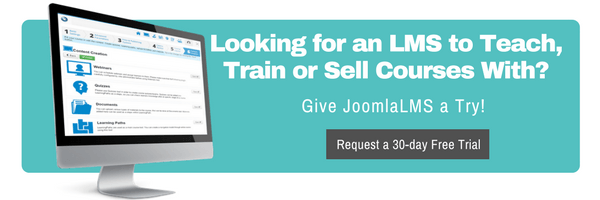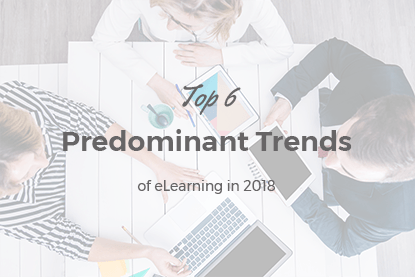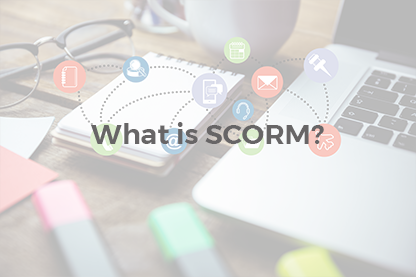ELearning is the wave of the future! – blog headlines say. “Hmm, I should keep up with the trends and build my own eLearning school/sell courses online/train my employees” - you decide one morning. Excited about the idea you start searching for the right solution and find yourself completely lost among hundreds of unknown terms – LMS, Authoring tools, SCORM, AICC, flipped classroom, rapid learning, instructional design, LTI, Tin Can API etc. It’s not all that simple as it happens!
TIP: New to eLearning? The article features a list of the “must-know” eLearning terms commonly used in the eLearning industry by LMS vendors, instructional designers, course developers and learning and development managers.
Click on any eLearning term and you will be quickly forwarded to its definition.
ELearning is the wave of the future! – blog headlines say. “Hmm, I should keep up with the trends and build my own eLearning school/sell courses online/train my employees” - you decide one morning. Excited about the idea you start searching for the right solution and find yourself completely lost among hundreds of unknown terms – LMS, Authoring tools, SCORM, AICC, flipped classroom, rapid learning, instructional design, LTI, Tin Can API etc. It’s not all that simple as it happens!
Do you recognize yourself?
I am sure you do, because I was in your shoes when I first started working for JoomLMS.
Not to let you get lost we collected the “must know” terms in one blog post.
Must-Know ELearning Terms
AICC Asynchronous Learning Authoring Tool Blended Learning Case-based storytelling Cloud Cloud LMS CMS Competency-based Learning Corporate Training ELearning ELearning Content Chunking ELearning Personalization Face-to-face Learning Flipped Learning Formal Learning Game-based Learning Gamification HTML5 Informal Learning Installed LMS Instructional Design Just-in-time Learning K-12 LCMS Learning Path Learning Snacks Lifelong learning LMS LTI Micro-Learning MLearning MOOC “One size fits all” ELearning Model Problem-based Storytelling Rapid Learning Responsive Design LMS ROI Scalable LMS Scenario-based Learning SCORM Self-paced Learning Social Learning Storytelling Student-Centered Approach to ELearning Synchronous Learning Tin Can Virtual Classroom WhiteboardAICC - a standard providing course content compliance with web-based learning requirements, facilitating a proper communication between the course content and the LMS.
Asynchronous Learning – a type of online learning that can happen even if a student is offline. A student can study at their own pace and communicate with the classmates and a teacher by means of posting questions at forums and sending emails.
Authoring Tool – software used to create a SCORM compatible eLearning content that can be deployed into any SCORM conformant Learning Management System without need to start all over again if you decide to move to another LMS.
Blended Learning - an instructional mindset in which online tools are leveraged to enhance the face-to-face learning that already exists within a classroom. Read more here
Case-based storytelling - bringing as examples cases that need to be resolved.
Cloud – a set of remote servers where the data is stored and can be accessed from anywhere.
Cloud LMS (also called SAAS, on-demand LMS, multitenant LMS) – a Learning Management System hosted in the cloud. Read more here
CMS (Content Management System) – a web-based application used to build a website and manage content within a common interface. The system of permissions allows multiple users to access the CMS without interfering with each other.
Competency-based Learning - an approach to learning designed to develop specific skills and competencies rather than abstract knowledge.
Corporate Training - an improvement of employees’ professional knowledge and skills that the company needs to conduct for its business success and development. Read more here
ELearning (also called distance learning, online learning, computer-based learning, web-based learning) – a type of learning that is delivered over the internet. The learning happens outside of a traditional classroom, by using an LMS to deliver learning materials and webinar services to replace a face-to-face communication. There are different eLearning techniques such as mLearning, blended learning, flipped learning, rapid learning, social learning etc.
ELearning Content Chunking - a process of dividing information into small pieces and grouping them together so they can be stored and processed easily. Read more here
ELearning Personalization - a method of customizing the right type of learning for the right type of audience. A personalized learning is the opposite of a “one size fits all” model used in a traditional education. A learning curriculum and activities are adjusted to students’ skills rather than to the age or grade.
Face-to-face Learning – a traditional learning that requires a teacher and students to be located in the same physical classroom.
Flipped Learning – a model of teaching in which students study learning material at home by watching videos and come to the class to get a deeper understanding of a topic, discuss unclear moments and interact with the classmates. Read more here
Formal Learning – a type of learning that is planned, structured and guided by an instructor/teacher.
Game-based Learning – the use of games in learning and training. The main idea is to help a student to apply the skills gained in games to a real-world environment.
Gamification – a type of learning implying the usage of game elements such as badges, levels, achievements, points etc. to increase students’ engagement in the learning process.
HTML5 (Hypertext Markup Language) – a markup language used to design courses accessible on mobile devices.
Informal Learning – an ongoing process of gaining new skills and knowledge through peers and colleagues observation, reading blogs and news sources, communication on forums, watching YouTube videos etc.
Installed LMS (also called on-premise LMS, deployed LMS, in-house LMS) – Learning Management System installed at the client’s server. Read more here
Instructional Design – a practice of analyzing, designing and developing instructional materials and transferring them into an online curriculum. Read more here
Just-in-time Learning – a type of learning focused on gaining particular knowledge instead of learning everything.
K-12 – a term standing for education prior to college (from kindergarten to twelfth grade).
LCMS (Learning Content Management System) – a system used to create and manage the eLearning content. The main difference between an LMS and an LCMS is the target user. An LMS focuses on learners, while an LCMS is primarily used by content creators.
Learning Path – a sequence of steps a student needs to take to pass the course and get a certificate.
Learning Snacks - very small bits of learning that are available on-demand from any device at any time. Read more here
Lifelong learning – a combination of a formal and informal learning continuing throughout a whole life.
LMS (Learning Management System) - software used for creation, managing and delivering eLearning content as well as communication with students and tracking their performance. There are Learning Management Systems hosted in the cloud and installed at the clients’ websites. The courses are either created with the help of native LMS tools such as documents, quizzes, links or uploaded as SCORM/AICC packages. Read more here
LTI (Learning Tools Interoperability) – a standard allowing LMS vendors to add integration with third-party services. It is a framework within which an LMS sends information about a learner to a third-party tool or software, enabling single sign-on, data exchange and a seamless user experience.
Micro-Learning– a way of teaching that implies delivering eLearning content in small units (chunks, learning snacks) for better retention and higher engagement.
MLearning – learning conducted by means of electronic devices such as mobile phones and tablets. The main idea is to let students study whenever they are and whatever device they use. For mLearning to happen the LMS needs to be either mobile responsive or have a mobile app. The courses need to be designed with the help of HTML5 compatible authoring tools.
MOOC (Massive Open Online Courses) – free online courses offered by top colleges and universities. The main idea is to give an opportunity to study to anyone independently of income and location. A fee is applied only if a student wants to get a certificate to confirm the knowledge.
“One size fits all” ELearning Model – a learning model suitable for all types of learners independently of their skills and the level of knowledge.
Problem-based Storytelling - teaching how to solve the problem with the best results.
Rapid Learning - a process of creating courses within shorter period of time, within smaller budget, making fewer efforts and involving minimum resources. Read more here
Responsive Design LMS – an LMS which layout adjusts to the screen of a device used.
ROI (Return on investments) – a performance indicator measuring the profit after all costs deducted. In relation to eLearning costs include the cost of course development, LMS, authoring tools etc. Read more here
Scalable LMS – an LMS that allows increasing the number of seats on demand.
Scenario-based Learning – a type of learning in which a learner becomes a part of the story and achieves different outcomes depending on certain decisions.
SCORM (Sharable Content Object Reference Model) - a collection of standards ensuring content compatibility with any SCORM compliant LMS. A SCORM compatible content is created with authoring tools and can be reused and transferred to a new LMS with no need to spend money and efforts on the content remaking. Read more here
Self-paced Learning – a type of learning directed by a student, not an instructor. A student determines the amount of time to study as well as a comfortable place to access the courses from.
Social Learning – a type of learning enhanced by exchanging information via social networks. Information associated with learning such as courses, certificates and grades is displayed on students’ social profiles evoking the effect of competition, striving for improving knowledge and skills not to lag behind the peers.
Storytelling - a process of presenting data by means of entertaining and memorable stories. Read more here
Student-Centered Approach to ELearning – a way of teaching in which a student is put at the very center of the learning process. A teacher adjusts a curriculum, materials delivery and class activities to the student’s skills and the level of knowledge. The student-centered classroom allows students not to just pass, but to learn in a deep and fundamentally appropriate way. Read more here
Synchronous Learning – a type of online learning that requires both a teacher and a student to be online at the same time. Communication happens through chatting and video conferencing.
Tin Can (also called Experience API or xAPI) – the next generation of SCORM eLearning standard allowing tracking learning activities happening outside the LMS (like attending conferences, writing blogs, social communication etc.)
Virtual Classroom – an online classroom where learning and collaboration happen. There is a chat, whiteboard, video and audio capabilities enabled.
Whiteboard – an application allowing drawing online.
Go Up
What to read next?
The Secret of an Effective ELearning Course [Infographic]
10 Ted Talks That Will Help You to Make ELearning Meet Modern Learners’ Needs
150 Amazing and Free Resources for ELearning









